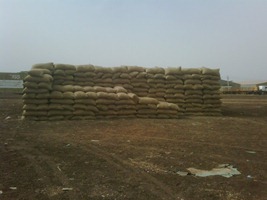 Current practice of storing the sorghum harvest in outdoor stacks exposes the grain to a build up of moisture and subsequent growth of mycotoxin producing fungiA new project will analyse different varieties of sorghum grown in various locations across Sudan for more than 20 different mycotoxins. Mycotoxins are toxic metabolites caused by growth of microscopic fungi in grains. Collection of samples will begin in March 2013 and continue throughout 2013.
Current practice of storing the sorghum harvest in outdoor stacks exposes the grain to a build up of moisture and subsequent growth of mycotoxin producing fungiA new project will analyse different varieties of sorghum grown in various locations across Sudan for more than 20 different mycotoxins. Mycotoxins are toxic metabolites caused by growth of microscopic fungi in grains. Collection of samples will begin in March 2013 and continue throughout 2013.
In addition to the analytical data, information about sorghum varieties, farming practices and storage facilities will be collected in a value chain study.
The combined analytical and value chain study data will provide an understanding of where problems with mycotoxins are most prevalent. Human intake of mycotoxins is a serious public health issue. Extremely high intake of mycotoxins may lead to acute mycotoxicosis. This happens only rarely. However, even much lower intakes may over time lead to a range of adverse health effects, such as induction of cancer and mutagenicity, as well as estrogenic, gastrointestinal and kidney disorders. In addition, certain mycotoxins are immunosuppressive and may reduce resistance to infectious disease.
The joint Food and Agriculture Organization of the United Nations (FAO)/World Health Organization (WHO) project will identify ways to reduce this problem. Sorghum is the main staple food in Sudan.
Under the leadership of Federal Ministry of Health, the Government of Sudan has established a national committee to guide the project. The committee has representatives from the Ministry of Health, Ministry of Agriculture, Sudanese Standards and Metrology Organization, the Central Laboratory, academia and the agro-business sector, as well as from FAO and WHO. The broad composition of the committee reflects the intersectoral nature of the problem and initiatives necessary to control it.
The project in Sudan is closely linked to three parallel national projects in Ethiopia, Burkina Faso and Mali, which are also among the major sorghum producing and consuming nations of Africa.
Data generated from all four projects will be aggregated and used by the Codex Alimentarius Commission to establish an international standard for the presence of mycotoxins in sorghum in international trade and thus protect public health. National standard setting in food usually follow Codex Alimentarius standards. By introducing a national standard for mycotoxins in sorghum, the Sudanese authorities will obtain a powerful tool to protect their population from excessive exposure to mycotoxins.



